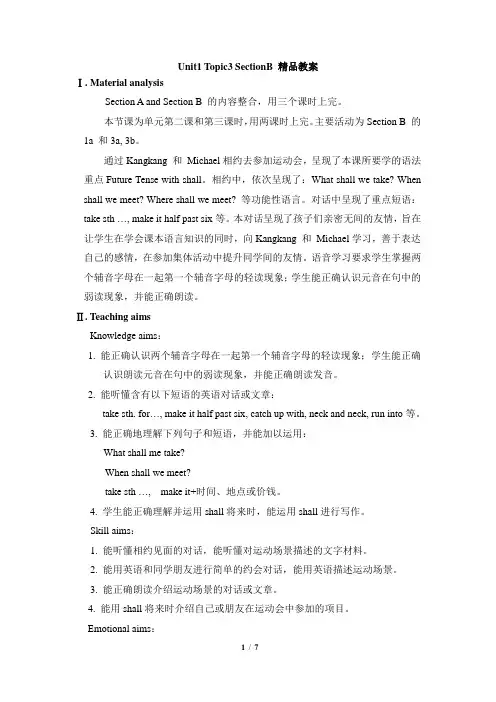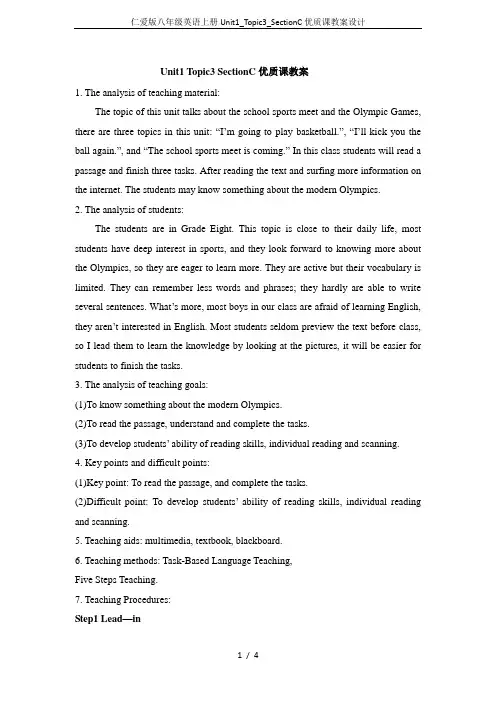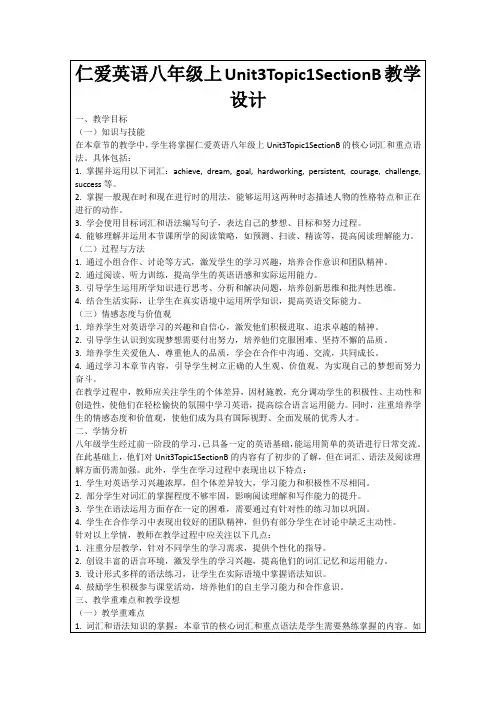最新推荐 仁爱八年级英语上册Unit3Topic1SectionB市级优质课课件
- 格式:ppt
- 大小:621.50 KB
- 文档页数:3

Unit1 Topic3 SectionB 精品教案Ⅰ. Material analysisSection A and Section B 的内容整合,用三个课时上完。
本节课为单元第二课和第三课时,用两课时上完。
主要活动为Section B 的1a 和3a, 3b。
通过Kangkang 和Michael相约去参加运动会,呈现了本课所要学的语法重点Future Tense with shall。
相约中,依次呈现了:What shall we take? When shall we meet? Where shall we meet? 等功能性语言。
对话中呈现了重点短语:take sth …, make it half past six等。
本对话呈现了孩子们亲密无间的友情,旨在让学生在学会课本语言知识的同时,向Kangkang 和Michael学习,善于表达自己的感情,在参加集体活动中提升同学间的友情。
语音学习要求学生掌握两个辅音字母在一起第一个辅音字母的轻读现象;学生能正确认识元音在句中的弱读现象,并能正确朗读。
Ⅱ. Teaching aimsKnowledge aims:1. 能正确认识两个辅音字母在一起第一个辅音字母的轻读现象;学生能正确认识朗读元音在句中的弱读现象,并能正确朗读发音。
2. 能听懂含有以下短语的英语对话或文章:take sth. for…, make it half past six, catch up with, neck and neck, run into等。
3. 能正确地理解下列句子和短语,并能加以运用:What shall me take?When shall we meet?take sth …, make it+时间、地点或价钱。
4. 学生能正确理解并运用shall将来时,能运用shall进行写作。
Skill aims:1. 能听懂相约见面的对话,能听懂对运动场景描述的文字材料。


八年级上册教案设计Unit 3 Our HobbiesTopic 1 What’s your hobby?Section AⅠ. Material analysisSection A的主要教学活动为1a和2。
通过Helen和Wen Wei的对话,呈现了本课所要谈论的话题: What’s your hobby?以及兴趣、爱好的不同表达形式,如like/enjoy/prefer/be fond of /be interested in +doing。
结合本单元的话题Our Hobbies, 呈现了大量的表示兴趣爱好的短语: go traveling, collect stamps, walk a pet dog, listen to music等。
“兴趣爱好”这个话题和学生们的生活紧密相联,容易激发学生的学习兴趣。
但要正确使用爱好的不同表达形式对学生来说还是有一定困难的。
所以,要求老师以课本文本内容为依据,结合学生的实际生活,引导学生正确地使用like/enjoy/prefer/be fond of /be interested in +doing谈论自己的兴趣爱好,并能书面表达自己及朋友家人的兴趣爱好。
Ⅱ. Teaching aimsKnowledge aims:1. 能根据音标正确拼读并运用单词表中的单词,如: hobby, poem, maybe等。
2. 能正确地用英语表达自己的喜好,如: go traveling,collect stamps,walk a petdog, listento music等。
3. 能正确地运用不同的方式,如: like/enjoy/prefer/be fond of /be interested in +doing结构来表达兴趣爱好。
4. 能运用本课所学语言,就自己和他人的喜好用英语进行交流。
Skill aims:1. 能听懂有关喜好的话题,并能听懂朋友的邀请。

Unit1 Topic3 SectionC优质课教案1. The analysis of teaching material:The topic of this unit talks about the school sports meet and the Olympic Games, there are three topics in this unit: “I’m going to play basketball.”, “I’ll kick you the ball again.”, and “The school sports meet is coming.” In this class students will read a passage and finish three tasks. After reading the text and surfing more information on the internet. The students may know something about the modern Olympics.2. The analysis of students:The students are in Grade Eight. This topic is close to their daily life, most students have deep interest in sports, and they look forward to knowing more about the Olympics, so they are eager to learn more. They are active but their vocabulary is limited. They can remember less words and phrases; they hardly are able to write several sentences. What’s more, most boys in our class are afraid of learning English, they aren’t interested in English. Most students seldom preview the text before class, so I lead them to learn the knowledge by looking at the pictures, it will be easier for students to finish the tasks.3. The analysis of teaching goals:(1)To know something about the modern Olympics.(2)To read the passage, understand and complete the tasks.(3)To develop students’ ability of reading skills, individual reading and scanning.4. Key points and difficult points:(1)Key point: To read the passage, and complete the tasks.(2)Difficult point: To develop students’ ability of reading skills, individual reading and scanning.5. Teaching aids: multimedia, textbook, blackboard.6. Teaching methods: Task-Based Language Teaching,Five Steps Teaching.7. Teaching Procedures:Step1 Lead—inLet’s enjoy a song: Pass the flame.The teacher asks students: Do you like this song? And do you know what the song is about?Pass the flame is the theme song of the Olympic Games in Athens in 2004. Do you want to know more about the Olympics?Step2 Presentation (pre—reading)Teacher shows some pictures about the modern Olympics on the PPT, let students find out the years and the host cities. They should learn to say these sentences:The modern Olympics started in Athens, Greece in______.In 2000 ______ held the 27th Olympic Games.In 2004______ hosted the28th Olympic Games.______ hosted the 29th Olympic Games in 2008.London held the 30th Olympics in______.The 31st Olympics was held in ______ in2016.Then ask them to think about the two questions:Do you know when the next Olympics will be held?Which city will host the next Olympic Games?Activity 1: Match the years with the host cities of the Olympic Games.2000 Rio2004 London2008 Beijing2012 Athens2016 SydneyNext we will learn: the symbol of the Olympics and what do the five rings stand for? Olympic motto is: Faster, Higher, Stronger!Step3 Practice (while—reading)Task 1: Read the passage 1a and choose the correct answers.( ) 1. The modern Olympics started in______.A. 1952B. 1896C. 1996D. 2000( ) 2. What is the symbol of the Olympic Games?A. The Olympic emblems(会徽)B. The Olympic mascots (吉祥物)C. The Olympic ringsD. The flag of each country( ) 3. What do the five rings stand for?A. Five parts of the worldB. Five countriesC. Five citiesD. Five colors( ) 4. The Olympic Games are held every ______ years.A. 2B. 3C. 4D. 5( ) 5. Which of the following is TRUE?A. You can find one color in the flag of each country.B. The players from all over the world meet to compete and they can’t be friends.C. Only in Athens the Olympic motto is “Faster, Higher, and Stronger.”D. The Olympic Games will be more and more popular and exciting.While students doing this part, the teacher writes down the key words and phrase on the black board, after finishing the task, teacher retells the passage according to these tips.Task 2: Retell the passageThe modern Olympics started in Athens, Greece in ______. Its motto is “Faster, ______, Stronger”. The Olympic rings are a ______ of the Olympic Games. There are five rings, and they______ (代表)the five parts of the world. The ______ and Winter Olympics are held every four years. Nowadays, different cities hold the Olympics Games______(轮流). The Olympics are becoming______(越来越.......)popular and exciting.Step4 Summary: complete the notes (post—reading)1. The year of the first modern Olympics: __________________________________.2. The host city of the first modem Olympics:_________________________________.3. The motto of the Olympics Games:_______________________________________.4. The symbol of the Olympics Games:______________________________________.6. The colors of the rings:________________________________________________.7. The Summer Olympic Games are held every______ years.Step5 Homework1. Read this passage aloud.2. Finish part 2, 3 on page 228. Blackboard designTopic 3 The school sports meet is coming. (Section C)The modern OlympicsStarted in: 1896Stand for: the five parts of the worldBe held: every four yearsIn the future: more and more excitingThe Olympic motto: Faster, Higher, Stronger!9. Teaching reflectionIn this class, I think there are three successful points:(1) Listen to a song to attract students’ interest.(2) Lead students to learn more by reading other materials.(3) I integrate the textbook effectively that can make students understand easily. But there is also shortcoming, I pay less attention to individual students, focus on their learning results.I believe I will do better after my hard work.。

博爱版英语教材讲堂教课观摩课教课设计任教课校:讲课教师:讲课班级:讲课时间:福州市教育学院附中林清淳初二( 10)班2006 年 11 月 23 日(礼拜四)下午第一节教材:湘教版八年级上册Unit 3 , Topic 1 Section B教具:教课方法:课件、收音机、白板、实物道具本节课主要采纳自主学习、合作研究的教课方法。
教课目的:依据新课程标准理念以及本课在教材中的地位和作用,联合学生的详细状况,定本课教课目的为:一.认知目标:1.进一步稳固本单元的要点词汇,要点句型;2.学习讨论自己和别人喜爱和不喜爱做的事,学会用enjoy、like、love、prefer、be interestedin 表达自己的兴趣喜好。
b5E2RGbCAP3.学会商论过去常做的事以及与此刻常做的事作对照。
二.能力目标:学生在掌握语言知识后1.经过学生的自我评论培育学生自我调控能力。
2.经过对教材的整体输入提升学生的听力水平。
3.能依据所给出的个人喜好话题进行简单对话、能使用图片或借助其余帮助,描绘自己或他人的个人喜好并在教师的指导下,能供给相关个人状况和个人喜好的信息。
p1EanqFDPw4.在各项活动中学生一同参加评论,实现学生的评论主体地位。
三.感情目标:1.经过这堂课的预习工作,培育学生的自学能力。
2.经过这堂课的学习过程,把个体学习变成合作学习。
3.培育学生的兴趣喜好和对生活、将来的一种踊跃态度,建立正确的人生观。
引入竞争体制,调换全体学生主动参加,知足初中孩子的表现欲,加强自信心,经过小组合作,培育团结协作的精神。
DXDiTa9E3d教课重难点:1.复惯用enjoy, like, love, prefer, be interested in等单词、词组表达自己的兴趣喜好。
RTCrpUDGiT2.学惯用 used to do sth. 联合以上的单词或词组来表达自己过去和此刻的兴趣喜好。
教课步骤:Step anization1.P lay some English songs。

Topic 1 What’s your hobby?教学内容分析及课时分配建议:本话题围绕业余爱好而展开。
主要内容包括:由Helen和 Wen Wei谈论空闲时间做什么引出话题--What’s your hobby ?在孩子们谈论业余爱好的过程中,引出本话题的语法知识used to do sth.和本话题的功能“喜欢和不喜欢”。
本话题除了介绍常见的业余爱好。
如:集邮、收藏物品、饲养宠物等还介绍了另类有趣的业余爱好。
如:制作剪贴薄。
还要求学生制作班级薄来培养学生的动手能力。
通过学习本话题,学生能够交流有关业余爱好的信息,丰富自己的业余生活。
本话题建议用5个课时来完成:第一课时:Section A—1a,1b,1c,1d第二课时:Section B—1a,1b,1c,2,3第三课时:Section A—2,3a,3b,Section B-4a,4b第四课时:Section C—1a,1b,2,3第五课时:Section D-Grammar and Functions,1,2,Project第五课时(Section D-Grammar and Functions,1,2,Project)教学设计思路:本课主要是归纳总结used to do 句型和表达喜欢不喜欢的句型。
首先在教师的引导下归纳总结句型,然后快速完成Grammar 和Functions 。
做完复习后,教师通过图片,导入新词汇,为阅读1做准备。
扫除词汇障碍后让学生速读1并完成表格。
核对完答案,学生对短文有了大致的了解。
接下来就让学生精读短文,小组合作并在教师的帮助下解决难点,完成1。
接下来让学生进行小组活动,完成2。
最后进行Project,完成本课时。
Ⅰ. Teaching aims1.Knowledge aims:(1)学习并掌握新词汇everyday,snake,provide,pig,dirty,owner,comfort,bath,pond,unfriendly(2)归纳总结表示喜欢和不喜欢的句型及used to do句型。

教材:仁爱版八年级上册Unit 3 , Topic 1, Section B教具:收音机、白板、图片,实物道具教学方法:本节课主要采用自主学习、合作探究的教学方法。
教学目标:一.认知目标:1.进一步巩固本单元的重点词汇,重点句型;2.巩固用 enjoy、like、love、prefer表达自己或他人喜欢和不喜欢做的事、学习用be interested in等表达自己的兴趣爱好。
3.学会用used to do sth.谈论过去喜欢做的事以及与现在做的事变化。
二.能力目标:学生在掌握语言知识后1.培养学生听,说,读,写的全方面能力,引导他们自主学习;2.通过学生的自我评价培养学生自我调控能力。
3.能根据所给出的个人爱好话题进行简单对话、能提供有关个人情况和个人爱好的信息。
4.在各项活动中学生一起参与评价,发展学生的评价能力。
三.情感目标:1.通过这堂课的学习过程,把个体学习变为合作学习,形成学习的合力。
2.培养学生的兴趣爱好和对生活、未来的一种积极态度。
3.引入竞争机制,调动全体学生主动参与,满足初中孩子的表现欲,增强自信心,通过小组合作,培养团结协作的精神。
教学重难点:重点在于熟练掌握用enjoy, like, love, prefer, be interested in表达自己兴趣爱好。
难点:将自己现在的兴趣爱好与以前比较,用used to do sth..表达自己爱好的变化。
教学步骤:Step 1. ChantStep 2. OrganizationStep 3. Revision1. Dialogue competition2. Words competition3. Ask Ss to talk about “What do you love doing?”. Use the words or the phrases “enjoy, prefer, favorite, love, like, etc.”Step4. Presentation1. Lead in.2. Listen and choose the right answers.Step 5. Practice1. Play the tape and ask a row to repeat sentences without looking at the books.2. Read the dialogue in groups.( exchange)3. Practice in pairs.4. Act out the dialogue.Step 6. Listen, read and understand.1. Lead-in.2. Play the tape and listen to 2a (once) and finish off 2b.(without looking at the book)3. Read the passage 2a once again and check the answer by Ss.4. Check the answers together.5. Mainpoints.Step 7. Consolidation.Step 8. Homework.教学过程:Step 1 ChantStep 2 OrganizationStep 3. Revision1. Dialogue competition.1) 看病2)谈论爱好 3)打电话、留言 4)谈论最喜欢的人物2.Words competition.T: Next the words will be shown by me. I will show you the Chinese meanings of some words. Please say them in English. Two words for each student. Row 5 , please.3. Make sentences with the words or phrases.(love 、like、favorite、enjoy、like…best、 be interested in、etc.)Step 4 Presentation1. Lead inT shows a picture about Part1a. T introduces the picture and write some useful language points on the blackboard.1) in one’s spare time Eg.2) need a change Eg.2. Listen and choose the right answer.T plays the tape recorder about 1a once, and choose the right answer.1)What does the boy often do in his spare time?( )A. go swimming B. go fishing C. go boating2) What does the girl often do in her spare time?( )A. listen to music B. do some outdoor activities C. watch movies3) Who needs a change?( ) A. The boy B. The girl C. Both of them4) Does the girl only watch movies in the theater? ( ) A. No, she didn’t. B. Yes, she did. C. No, he didn’t3. Play the tape once and ask a row to repeat it sentence by sentence without looking at the books.Step5 Practice1. Read the dialogue in groups. ( exchange)2. Practice in pairs.3. Act out the dialogue.Step 6 Listen, read and understand1. Lead in. Use two pictures to introduce the phrase “used to do sth”.2. Play the tape and listen to 2a once and finish off the form.Philip Used to Now Reasona movie fan. His interests are changing all the timeplay sports.3.Read the passage 2a once again and check the answer by Ss.4.Check the answer together.5.Mainpoints.1). Be interested in Eg.2). Know little about Eg.3). Share one’s interests Eg.4). Used to do sth Eg.Step 7 Consolidationbine 1b with 3. Divide the students into eight groups. Ask one student in each group to make a survey about their hobbies among their groups. Ask and answer one by one and the leader record the conclusion. Then the leader make a report for us. They can use these questions: What do you love doing now? 2) What did you use to do ?2.Fill in 1b.3.Report the data to the whole class according to the example in 3. After reporting, ask Ss to choose the winner.Step 8 Homework1. Review Section B and recite 1a.2. Write a composition about the report.2. Preview Section CBlackboard DesignUnit3 Topic1 Section B1.Practice.1)enjoy,love,like ect.2).A form of 2b2.A picture about 2aMain Points1.in one’s spare time2. need a change3. be interested in4. Know little about5. Share one’s interests6. Used to do sth Competition Table&Homework课后反思:本节课师生热情高涨,情绪饱满,师生的互动热烈。


教师学科教案[ 20 – 20 学年度第__学期]任教学科:_____________任教年级:_____________任教老师:_____________xx市实验学校八上仁爱版英语Unit 3 Topic 1 What hobbies did you useto have Section B 教学设计The main activities are 1a, 3a and 4. 本课重点活动是1a, 3a和4。
Ⅰ. Teaching aims and demands 教学目标1. Learn some useful words and expressions:spare, in one’s spare time, VCD, share, e-mail, address, pop2. Learn the pattern of“used to do sth.”:(1) I used to enjoy listening to music.(2) I used to know little about paintings.(3) I didn’t use to play soccer, but now I like it.3. Go on talking about interests and hobbies and learning how to express likes and dislikes:(1) My interests are changing all the time.(2) I used to enjoy listening to music, and I wasn’t interested in sports at all. But now, myhobbies are sports like soccer and swimming.(3) I used to know little about paintings. But now I like collecting them.(4) I used to collect stamps, but now I don’t like/enjoy it. I prefer collecting coins.(5) I didn’t use to go shopping, but now I enjoy it.Ⅱ. Teaching aids 教具录音机/光碟/连环画杂志/小黑板/课件/图片Ⅲ. Five-finger Teaching Plan 五指教学方案Step 1 Review 第一步复习(时间:12分钟)1. (检查上次作业,让学生说出自己家人的爱好。


八年级上册教案设计Unit 3 Our HobbiesTopic 3 What were you doing at this time yesterday?Section BⅠ. Material analysisSection B的主要教学活动为1a和2a。
本节课主要通过Jane和Michael之间的对话配合相应的图片,引出过去进行时和表达同意、不同意的句子。
Section B 的内容是对Section A的延伸,谈论的内容也从上个话题主要谈论过去某个时间在做什么,扩展到通过学生们熟悉的电影引出表示同意或者不同意的句子。
谈论电影、电视剧的话题是学生们最感兴趣的话题之一。
但是要学会正确使用不同的方式来表达自己的观点还是有一定的难度,所以在设计这堂课的时候,老师应该紧抓学生的兴趣点,通过采访、问答、编对话、视频、声音等不同形式练习表达情感的句型。
Ⅱ. Teaching aimsKnowledge aims:1. 能根据音标,正确朗读出单词表中的单词:agree, so-so, pleasant, brave, useful。
2. 能在老师的引导下,不断体会易混音的发音差异/l/,/n/,//。
读出重音、弱读、连读和不完全爆破,并了解到不同的读法可以表达不同的意思。
3. 能正确拼读并运用单词表中的单词, 如:agree, so-so,pleasant, brave, useful。
4. 能正确使用过去进行时, was/were +doing以agree, disagree的用法。
5. 能够用was/were 谈论过去某个时段正在发生的事情,能够用不同的方式表示同意或不同意。
Skill aims:1. 能听懂就过去某个时段正在发生的事情的阐述以及他人对某个观点的态度。
2. 能正确地表达过去某个时段自己或朋友在做什么,以及正确地表达自己的观点。
3. 能正确朗读课本的文本材料,能模仿录音读清楚重音、弱读及连读和不完全爆破。